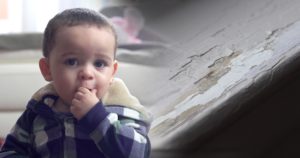 Lead poisoning is entirely preventable. However, over half a million U.S. children have blood lead levels high enough to damage their health. Evidence shows that the most common source of lead exposure for children today is lead paint in older housing and the contaminated dust and soil it generates. New England states have some of the oldest housing in the United States with over a third of New England housing built before 1950, where deteriorating lead-based paint is most likely to exist (Source: U.S. Census Bureau, 2010-2014 American Community Survey 5-Year Estimates). Although lead poisoning can cause serious health problems, especially in children younger than six years old, it is preventable.
Lead poisoning is entirely preventable. However, over half a million U.S. children have blood lead levels high enough to damage their health. Evidence shows that the most common source of lead exposure for children today is lead paint in older housing and the contaminated dust and soil it generates. New England states have some of the oldest housing in the United States with over a third of New England housing built before 1950, where deteriorating lead-based paint is most likely to exist (Source: U.S. Census Bureau, 2010-2014 American Community Survey 5-Year Estimates). Although lead poisoning can cause serious health problems, especially in children younger than six years old, it is preventable.
What is Lead?
Lead is a highly toxic metal that has been commonly used in many household, industrial, and automobile products, including paint, solder, batteries, brass, car radiators, bullets, and pottery.
Causes of Lead Poisoning
Lead can get into your body in various ways, including by ingesting or breathing dust from lead paint, ingesting lead chips, drinking tap water that has lead in it, eating fruits or vegetables that have lead on them from the soil, and eating food that has been prepared or stored in dishes made with lead.
 The most common source of lead poisoning in New England is lead-based paint. Lead in residential paint was banned in 1978 by the Consumer Product Safety Commission. However, most houses built before 1978 contain lead. Lead paint can turn into lead paint chips and lead dust as paint ages, when homes are repaired or renovated, and from the normal wear and tear of daily living, such as opening and closing wooden windows and doors, walking on painted floors, or hitting trim with a piece of furniture.
The most common source of lead poisoning in New England is lead-based paint. Lead in residential paint was banned in 1978 by the Consumer Product Safety Commission. However, most houses built before 1978 contain lead. Lead paint can turn into lead paint chips and lead dust as paint ages, when homes are repaired or renovated, and from the normal wear and tear of daily living, such as opening and closing wooden windows and doors, walking on painted floors, or hitting trim with a piece of furniture.
While anyone can get lead poisoning, lead is most dangerous to children younger than six years old whose brains are still developing. Those children who live in or frequently visit older housing are at the greatest risk for exposure. Young children can be poisoned when they put their hands, toys, and other objects, which may have lead dust on them, in their mouths.
Childhood Lead Poisoning
Childhood lead poisoning is one of the most common pediatric public health problem, yet it is entirely preventable. Once a child has been poisoned, the impairment it may cause is irreversible. Unborn babies and children are particularly vulnerable to the impacts of lead poisoning due to their still-developing brain and nervous system.
While no amount of lead in the body is safe, the effects of lead depend upon the level of lead in the blood. In children, very high levels can cause deafness, blindness, coma, convulsions, and even death. Moderate levels can also harm the brain and nervous system, kidneys, and liver. Even very low levels, which may not cause any obvious symptoms, are associated with learning disabilities, behavioral problems, decreased growth, impaired hearing, and speech delays. These problems remain long after childhood. Compared with children who have not been exposed to lead, children who have been exposed are much more likely to have problems with reading, vocabulary, attention, fine-motor coordination, school attendance, and academic achievement. They are also more likely to drop out of high school.
Lead poisoning is, for the most part, silent. Most poisoned children have no symptoms, so the vast majority go undiagnosed and untreated. Identifying and eliminating sources of lead in your child’s environment is the best way to prevent lead poisoning.
Could my child be at risk for lead exposure?

- Do you live in a home built before 1978?
- Does your child spend time in a home built before 1978?
- Does your child spend time with an adult whose job exposes him or her to lead (e.g., constructions, painting, metal cutting, recycling)?
- Does your child frequently put objects in his or her mouth?
- Have you moved to an older building since your child’s last blood lead test?
If you answered yes or don’t know for any of these questions, ask your doctor for a blood lead test for your child.
Adult Lead Poisoning
 Most adult lead poisoning comes from lead exposure in the workplace or through hobbies. Occupations with common lead exposure include renovation and repair, marine craft building and restoration, and manufacturing. Workers can be exposed to lead by breathing in or ingesting lead fumes or dust. Workers can also bring home lead dust in their clothes and shoes, which can poison other family members.
Most adult lead poisoning comes from lead exposure in the workplace or through hobbies. Occupations with common lead exposure include renovation and repair, marine craft building and restoration, and manufacturing. Workers can be exposed to lead by breathing in or ingesting lead fumes or dust. Workers can also bring home lead dust in their clothes and shoes, which can poison other family members.
It is possible to have lead poisoning without noticing any symptoms. Even if you feel fine, lead can start building up in your body and may damage your kidneys, brain, digestive, reproductive, and blood systems. Lead exposure can lead to health problems in adults, including miscarriage in pregnant women, decreased fertility in men, high blood pressure, digestion issues, issues with memory and concentration, and muscle and joint pain. Early signs and symptoms of lead poisoning include fatigue, uneasy stomach, irritability or nervousness, poor appetite, headache, sleeplessness, and/or a metallic taste in mouth.
How is Lead Poisoning Diagnosed?
The only way to know if someone has lead poisoning is a simple blood test. Children and adults who are at risk for lead poisoning should talk to their healthcare provider about getting a blood lead test.
Resources
- Housing and Urban Development’s (HUD’s) About Lead-Based Paint
- EPA’s Lead information
- Lead Safe Illinois’ The Ripple Effects of Childhood Lead Poisoning

